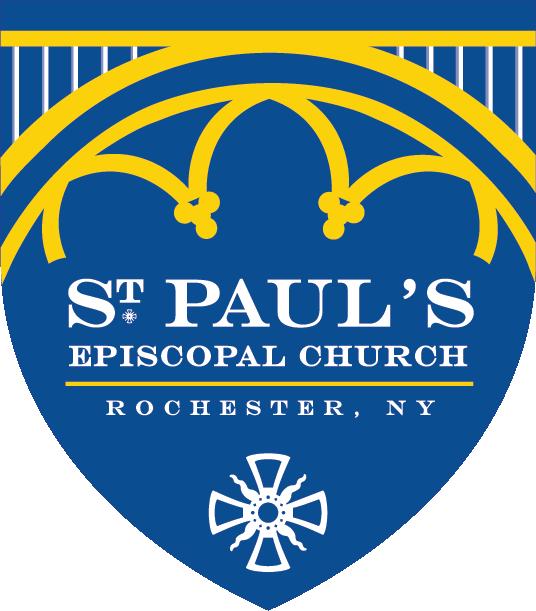
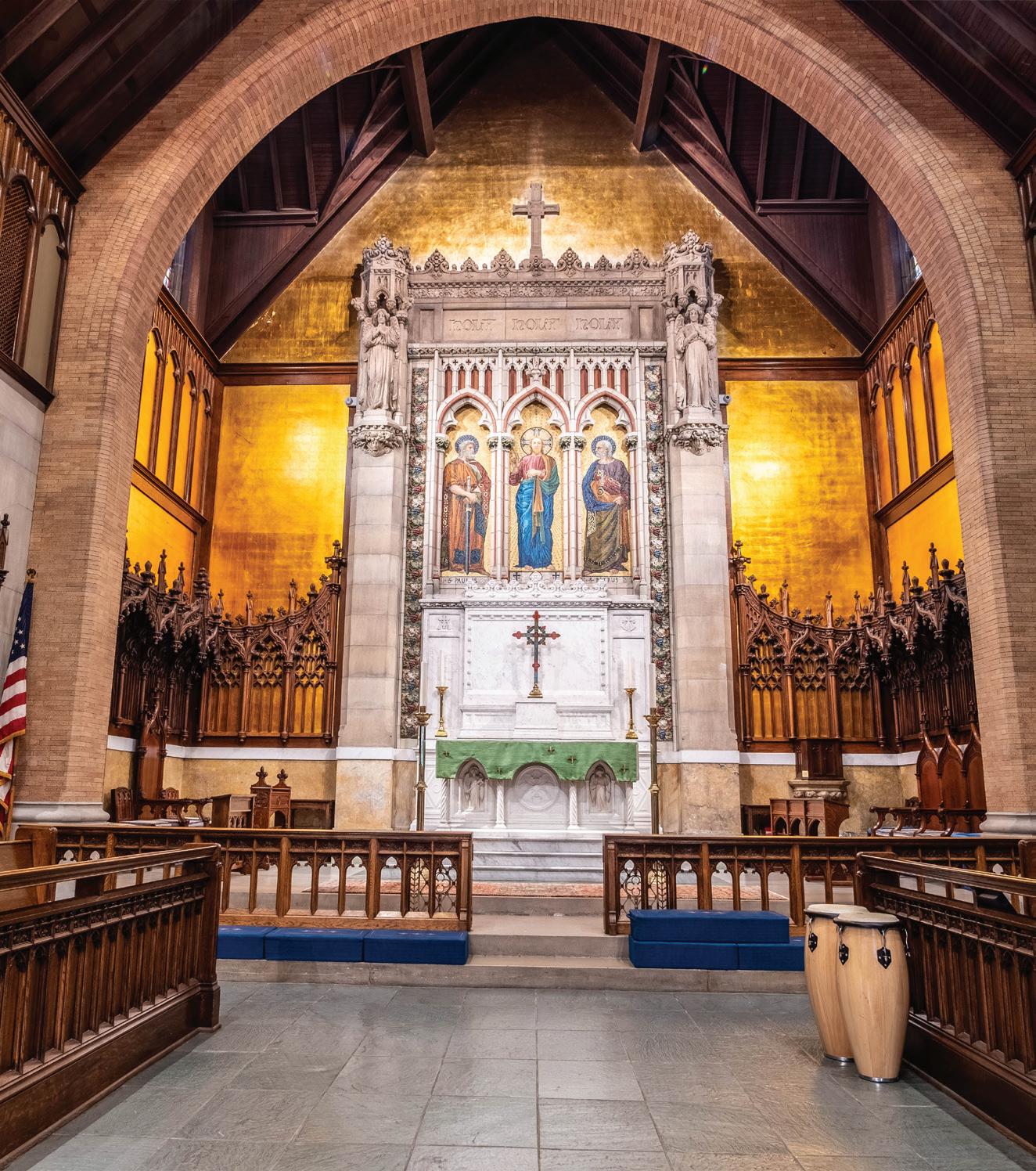



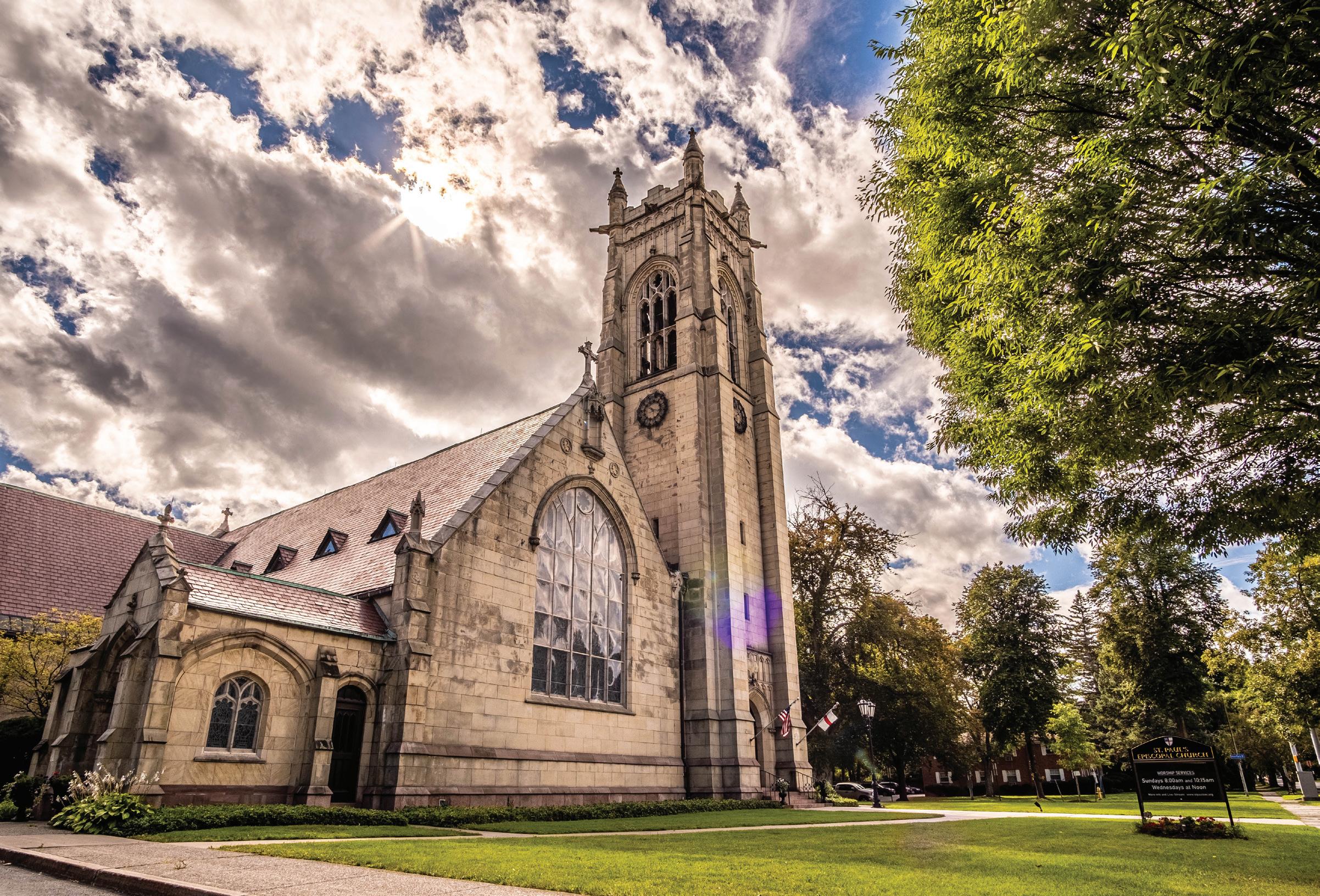

St. Paul’s Episcopal Church was founded in 1827 on Rochester’s Market Street, which was renamed St. Paul Street in honor of the parish. It was the second oldest Episcopal church in Rochester after St. Luke’s, which was founded in 1817. Rochester was the second city in New York State to have two Episcopal churches, the first being New York City.
In 1897, the present building was completed after the congregation decided to move from the bustling city. The architects were Heins and LaFarge of New York City; the contractor was Thomas Finucane. The church was built in the English Gothic style of mainly sandstone and brick with a slate roof. Some items from the first downtown
building were incorporated into the new structure.
The many beautiful windows and other sacred items that depict our Biblical heritage were given to the Glory of God and as memorials or honorariums, and were made possible by the generosity of many parishioners who worshiped here over the years.
The next page lists window locations by number and artifact locations by letter on a map. Photos and written descriptions are found on pages following the map. OR, use the numbers and letters QR codes, which are near the particular windows and/or artifacts.


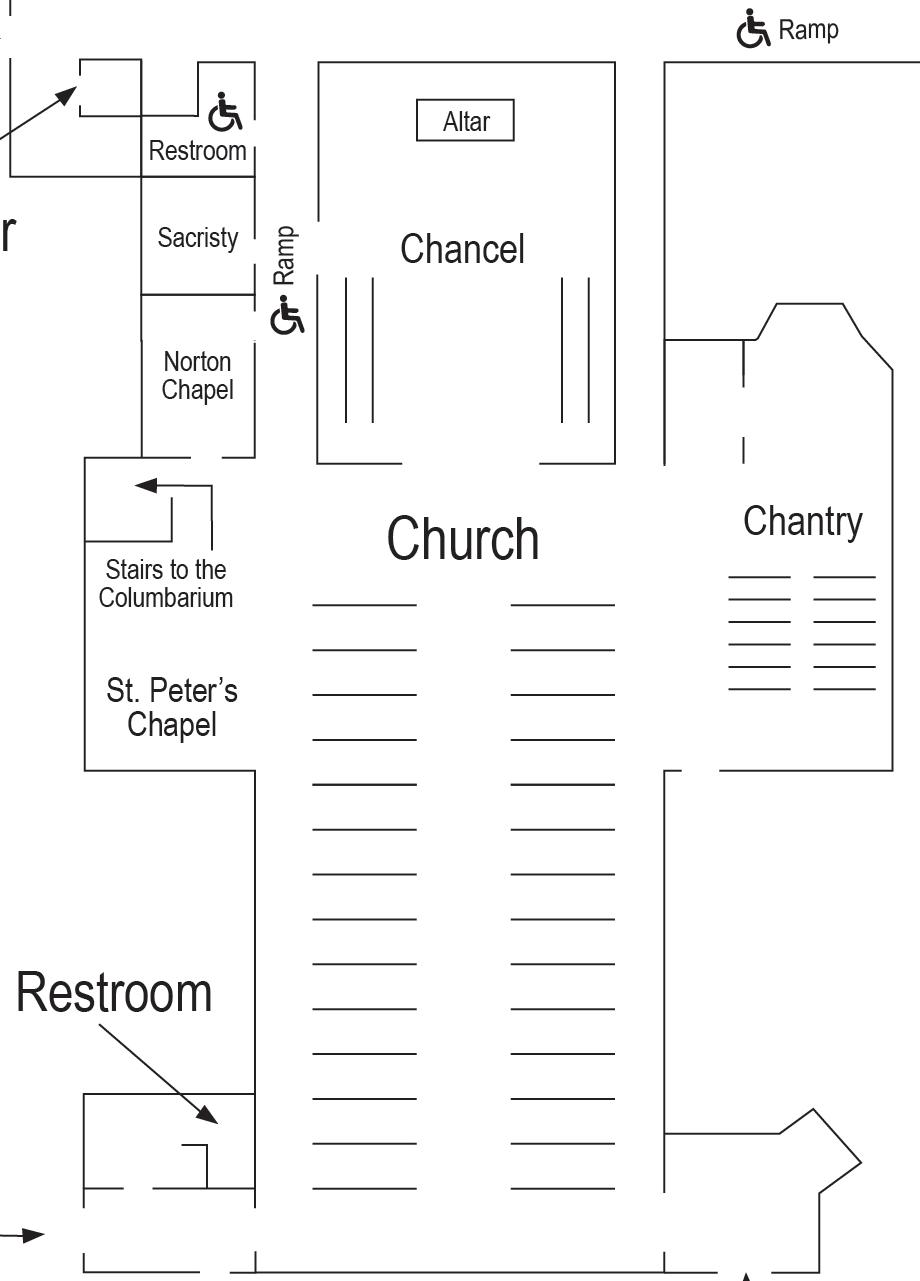




St. Paul with Sword of the Spirit (Ephesians 6:17) and St. John with Chalice and Serpent: Legend says that poison given in a cup to St. John turned into a snake and slithered away, saving his life. In the trefoil above these two saints is the Latin formula for the Trinity. The window was given in memory of Mr. and Mrs. J. R. Elwood by their children.

The Good Shepherd (Isaiah 40:11) and Jesus Receiving the Little Children (Matt. 19:14): In the trefoil above are three Easter lilies. This window was given in memory of Charles Elihu Mumford (18441845) by his parents, Mr. and Mrs. G. H. Mumford.
RIGHT: Drawing of original St. Paul’s Sanctuary showing windows, altar, and Baptismal font, which were transferred to their current location.
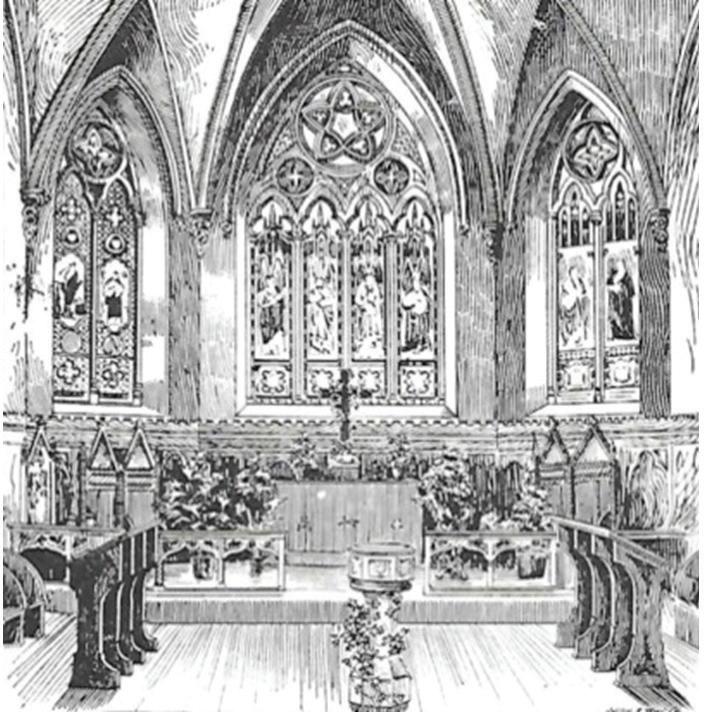


3, 4, 5,
Six of our stained glass windows were created by the Louis C. Tiffany Studios in New York City between 1898 and 1909. Five of these hang in the Chantry, the other is found in St. Peter’s Chapel. The four of them seen here have surrounded the Chantry altar since 1898.
Mary, Jesus, and John the Baptist (St. John the Baptist looking over Mary’s shoulder). Doves, blood red flowers and a shepherd with his flock portend things to come. It was given in memory of Hiram Sibley, Jr. (1875-1886) and John Durban Sibley (1883-1888).
The Good Samaritan—One man comforting another, perhaps the Good Samaritan, although there are no records of the original intent of the designer. It was given in memory of Jonas Jones, MD (died December 4, 1892).
The Parable of the Talents (Matt.25:21).—“Well done, good and faithful servant…Enter thou into the joy of the Lord.” It was given in memory of Sarah Antionette Jones (died February 4, 1898).
The Lord is My Shepherd (Psalm 23). This window as given in memory the Rev. Israel Foote, DD, 1817-1895, ‘For many years Rector of this Parish.’
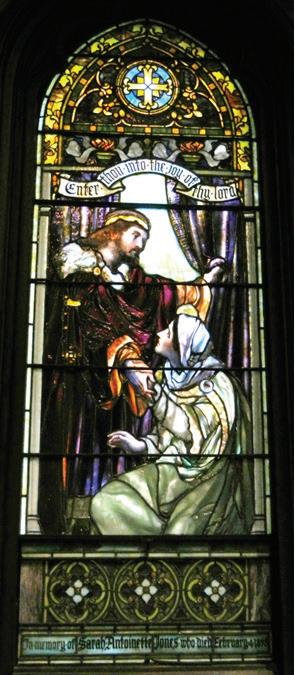
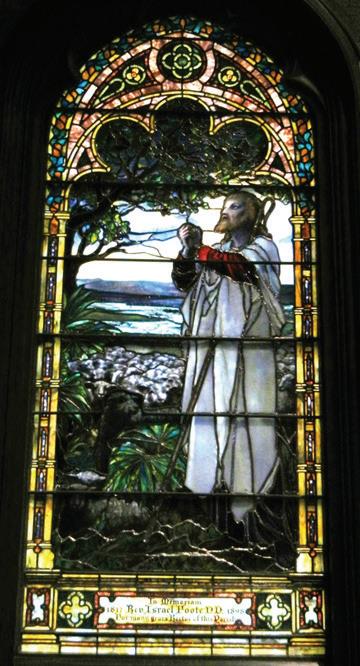
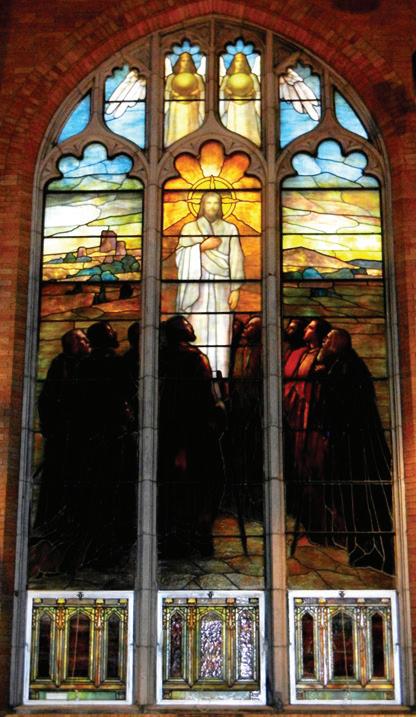
Dove of the Holy Spirit surrounded by the blue of Divine Wisdom. The window was created by Connick Brothers of Boston and installed in 1957. It was given in memory of Todd Marvin Crippen (1943-1956) by his mother, Adelaide Bickford Crippen.

Ascension of Christ (Luke 24: 50-51 and Acts 1:10-11): The 11 remaining apostles watch the rising Christ, while over their heads two dominion type angels support worlds. The window was installed in 1909 but the maker is unknown. It was given in memory of Arthur Gould Yates (December 1848 – February 1909)
BELOW: Both windows showing their relative placement on the west Chantry wall.

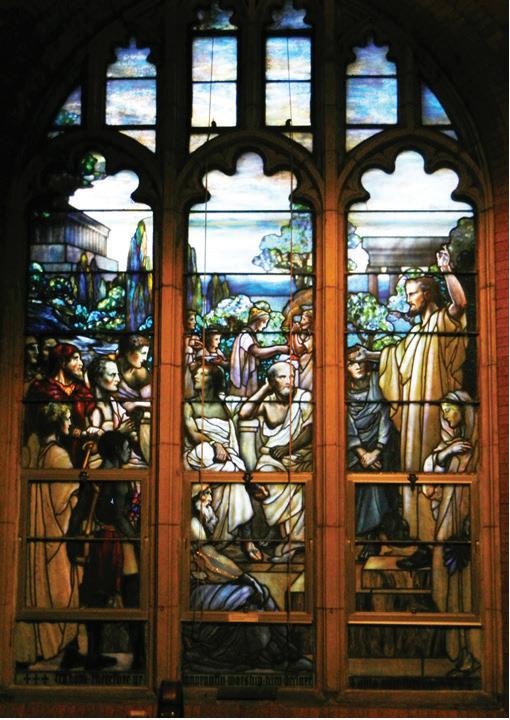
St. Paul Preaching in Athens upon finding the altar to an unknown god (Acts 17: 23): This Tiffany window, given in memory of Charles J. Bissell, is found on the north, or rear, wall of the Chantry. It was dedicated in 1908.
“Worship Him in Spirit and in Truth” (John 4:23-24): This lancet window in the Chantry entrance/vestibule shows an angel carrying a censor—a symbol of praise. It was given in memory of Ralph Herberg Frank, 1899-1955.
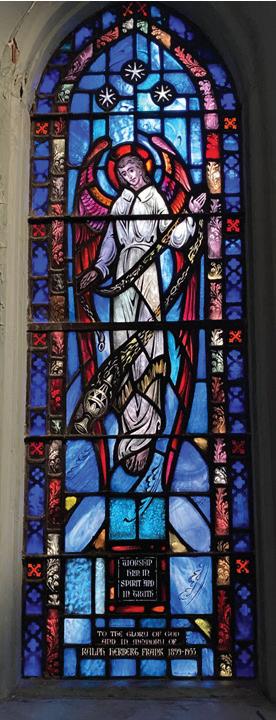
The four windows in the nave and the one in the north wall of St. Peter’s Chapel are devoted to saints who were prominent in the life of St Paul: St. Barnabas, St. Silas, St. Lydia, St. Timothy, and St. Luke. The two side lancets of each window show incidents in the lives of the saint, and below each panel in the quarry field are parallel incidents taken from the Old Testament or from the Gospels. In the top of the side lancet and the tracery of each window are six little figures holding scrolls and miniature cities representing 24 places connected with St. Paul’s ministry and grouped around the Saint with whom they are most closely associated. In the top of the side lancets and the tracery above are 12 cherubs, symbolizing the apostles. Scattered throughout the windows are crosses of various types and other early Christian symbols such as anchors and Greek letters which stand for Jesus or the Christ. The lives of these saints exemplify certain virtues, and these are suggested by symbolizing the opposite vice on a pedestal under their feet. All were created by Connick Brothers of Boston and installed between 1925 and 1957.
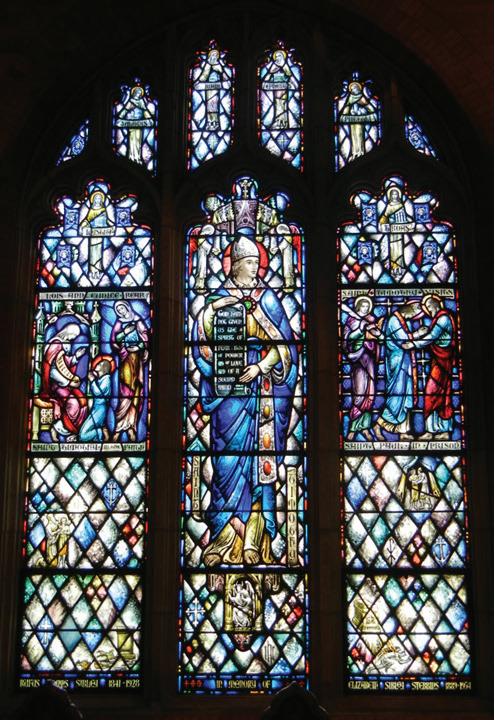
St. Timothy as Bishop of Ephesus [left panel raised in the faith by Lois and Eunice (II Timothy 1:5) and right panel Timothy and Luke visit Paul in prison (II Timothy 4:9-12):
The window was given in memory of Rufus Adams Sibley (1841-1928) and Elizabeth Sibley Stebbins (1889-1954). 11
St. Timothy was especially commended for his unfeigned faith. Therefore, on the pedestal stands a blindfolded devil to symbolize Doubt. As Bishop of Ephesus, St. Timothy is portrayed with cope and miter, and holding the verse, “For God hath not given us the spirit of fear; but of power, and of love and of a sound mind” (II Tim. 1:7).
In the left-hand panel, St. Timothy is being taught by his mother and grandmother, “Lois and Eunice rear St. Timothy in the faith” (II Tim. 1:5). Above this panel in the quarry field is a lamp symbolizing Faith. Below is the parallel Old Testament story of Elli teaching the boy Samuel (I Samuel 1:9-11; 19-28). In the right hand panel St. Timothy visits St. Paul in prison, with St. Luke standing by taking notes. This incident shows the friendship between St. Paul and St. Timothy (II Timothy 4:9-12). Below is the Old Testament friendship of David and Jonathan (I Samuel 18:1).
At the bottom of the left panel is the broken image of Diana (or Artemis) fallen from her pedestal. Her temple was located at Ephesus and merchants who sold Diana souvenirs complained when business fell off due to the influence of Christians (Acts 19:23-31). An emblem of St. Timothy at the base of the right hand lancet is a demon sulking away from a sarcophagus. A legend states that demons always showed great uneasiness near St. Timothy’s tomb, and St. Chrysostom tells how they fled when those possessed of demons approached it. Above are the symbols of the six cities: Lystra, where St. Timothy was born; Rome, where he visited Paul; Pehesus, because he was Bishop of Ephesus; Tarsus, whither he accompanied St. Paul; and Puteoli and Salamis.
The four windows in the nave and the one in the north wall of St. Peter’s Chapel are devoted to saints who were prominent in the life of St Paul: St. Barnabas, St. Silas, St. Lydia, St. Timothy, and St. Luke. The two side lancets of each window show incidents in the lives of the saint, and below each panel in the quarry field are parallel incidents taken from the Old Testament or from the Gospels. In the top of the side lancet and the tracery of each window are six little figures holding scrolls and miniature cities representing 24 places connected with St. Paul’s ministry and grouped around the Saint with whom they are most closely associated. In the top of the side lancets and the tracery above are 12 cherubs, symbolizing the apostles. Scattered throughout the windows are crosses of various types and other early Christian symbols such as anchors and Greek letters which stand for Jesus or the Christ. The lives of these saints exemplify certain virtues, and these are suggested by symbolizing the opposite vice on a pedestal under their feet. All were created by Connick Brothers of Boston and installed between 1925 and 1957.
St. Lydia of Philippi, Seller of Purple :
In the center panel stands the Saint, “a seller of purple”, holding a pitcher and glass to symbolize hospitality.
The left panel represents the conversion of St. Lydia: “And Lydia head us; whose hear the Lord opened” (Acts 16:11-15). The “hand of God” and a dove can be seen in the rays leading to Lydia’s head. This is the first recorded instance in the Bible of the conversion of a European. Below is a parallel episode from the Old Testament where the people of Baal of converted by Elijah (I Kings 19:39).
The right panel depicts the hospitality of Lydia. “St. Paul and St. Silas and St. Timothy enter the house of Lydia” (Acts 16:40).
Below in the quarry field is a figure of Abraham entertaining the angels (Genesis 18:18).

The window was given by the parish in 1956.
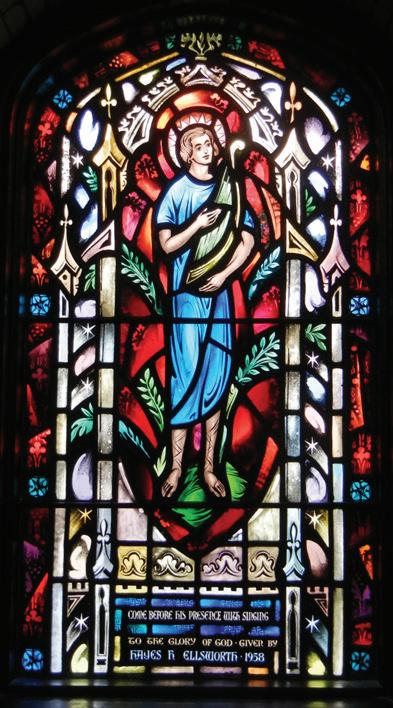

Young David with Harp: David, shepherd and singer …“Come before his presence with singing” (Psalm 100:2). This window was given by Hayes H. Ellsworth, who for more than 50 years was the Sexton of St. Paul’s Church. Connick Brothers of Boston; 1958.
Welcoming Christ: surrounded by a radiant canopy that suggests the gate of heaven. “Surely the Lord is in this place” (Genesis 28:16) as spoken by Jacob. Connick Brothers of Boston; 1958. It was given by Maybelle Case Parfett in 1958.
Jesus the Good Shepherd: This transom window over the north entrance door denotes Jesus’ statement, “Come to me, all you that are weary and carrying heavy burdens, and I will give you rest” (Matthew 11:28). It was given by the people of St. Paul’s in celebration of the ministry of the Rev. Frederic and Jane Reynolds upon Frederic’s retirement as rector in 2014. The window was created by Godfrey Muller Studios of Rochester, NY.
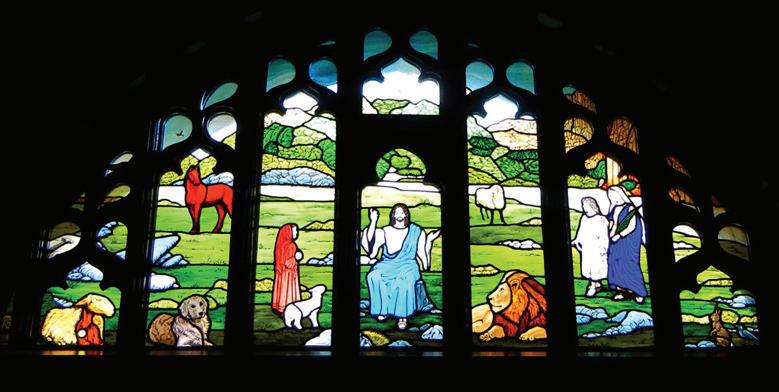
The Ministry of St. Paul and St. Peter: Connick Brothers of Boston; 1925 In the Great North Window, entitled “The Ministry of St. Paul and St. Peter”, the commanding center positing is given to the figure of Christ, surrounded by a vesica of white, with red-winged seraphim at either side above, and blue-winged cherubim below. He is clothed in a blue robe of Heavenly Truth and a flaming red tunic denoting Divine Love; underneath Him is the kneeling figure of St. Paul, then Saul of Tarsus. The nimbus (halo) about His head contains a cross denoting Deity. The words, “Saul, Saul, why persecutest thou me?” are found at Christ’s feet. The figure of St. Paul at the left holds an open book and the sword of the Spirit. Shown with him are the symbol of the three fountains near his feet and the heraldic shield inscribed with the crossed swords above his head. Inscribed on the open book are his words, “For to me to live is Christ, and to die is gain” (Philippians 1:21).

The words “St. Paul, Apostle to the Gentiles” surround the upper part of the figure, and the inscription at this feet is, “Paul a servant of Christ separated unto the Gospel of God.” He wears the flaming red mantle significant of achievement.
The figure of St. Peter at the right of the center lancet also is clothed in red and gold. The inscription surrounding his head is “Saint Peter, Apostle to the Hebrews.” At his feet are the words, “Simon Peter, Servant and Apostle of Jesus Christ.” He holds an open book and keys of gold and silver, his traditional symbols. On the open book are the words, “Thou are the Christ, the Son of the Living God” (Matther 16:16). Near his feet are three cocks in gold on a red ground, symbols of the glorification through divine love of the incident of St. Peter’s denial of Christ (Matthews 26:69-75).
(More on next page)
In the medallions surrounding the center lancets are shown significant incidents in the lives of St. Paul and St, Peter.
Beneath the figure of St. Paul is the depiction of Saul prior to his conversion receiving a letter from the High Priest sending him to Damascus (Acts 9:1-2).
The medallion, under the figure of St. Peter and to the right of the crouching figure of St. Paul, shows Ananias healing St. Paul’s blindness (Acts 9:10-19).
Below, in the center medallion, is a representation of St. Paul’s baptism; the one on the right, the meeting of St. Peter and St. Paul; and on the left, St. Paul preaching in the Synagogue at Antioch (Acts 11:22-26). The subjects in the left lancet continue the theme.
In the lower left corner is St. Paul’s healing of a cripple in Lystra (Acts 14:8-18); above is the incident of the jailer’s conversion (Acts 16:25-40); St. Paul preaching in Athens (Acts 17:16-34); and in the upper left corner, St. Paul defending himself before King Agrippa (Acts 26:1-30).
In the extreme right lancet, in the bottom panel, to balance the healing of the cripple of Lystra, is the raising of Dorcas by St. Peter (Acts 9:40); St. Peter’s delivery from jail by the angel (Acts 12:711); St. Paul and St. Peter accused before Nero; and the parting of St. Peter and St. Paul.
In the tracery pieces are symbolic figures representing the seven Churches: Galatia, Colossae, Ehesus, Philippi, Thessalonica, and Rome, the latter being the top tracery piece. On either side of the center tracery member are the Archangels Michael and Gabriel, guardian angels of the early Church.

The pieces in the smaller tracery are the symbols of the Four Evangelists – the winged man of St. Matthew, the winged lion of St. Mark, the winged ox of St. Luke, and the eagle of St. John.
The other small panels show prophets and kings and heroes of the Old Testament mentioned by St. Paul. Across the base section is the memorial inscription accompanied by the family arms of Abbey and Cutler. The window was given in memory of Anna Katherine Cutler, who died in 1924, by her husband James, in 1925.

The Nativity Window in the transom over the porte cochere entrance was given in loving memory of the Reverend Robert. M. Wainwright, Rector of St. Paul’s Parish, by his wife Nancy and sons John, Andrew, and Timothy. The window was created by Godfrey Muller Studios of Rochester, NY.
Isaiah with Angel and Moses with the Burning Bush (Hosea, Amos, Elijah, Jonah, and Micah above). The left-hand panel depicts Isaiah kneeling and looking up at a seraph with a live coal in his hand. The angel is cleansing Isaiah’s lips (Isaiah 6:5-6). In answer to the voice of the Lord, Isaiah says, “Here I am; send me” (Isaiah 6:8). The right-hand panel shows Moses and the burning bush. “The place whereon thou standest is Holy ground” (Exodus 3:5). In the tracery above are the figures of five minor prophets: Elijah at the top; Hosea, Amos with a shepherd’s crook; Jonah holding a fish; and Micah with a broken sword (“beat swords into ploughshares” or “nation shall not lift up sword against nation”).
—Connick Brothers of Boston; 1976


Samuel in the Temple: ”Speak for thy servant heareth” (I Samuel 3:1-10). “Not as though I had already attained or either were already perfect; but I follow after, that I may apprehend that which also I am apprehended of Jesus Christ” (Philippians 3:12).
When installed by Connick Brothers in 1958, this window on the south wall of the porte cochere entrance was on an outside wall. The Macomber Room now stands between the window and the exterior. Lights mounted behind the window can be turned on to make the colors visible.
It was given in memory of R. Elliot Cherne, Jr. by his parents in 1958.
Marriage in Cana: On the east wall of the Macomber Room is the window named “There was a marriage in Cana of Galilee” (John 2:1) with Jesus turning water into wine.
Jesus Raising Jairus’ Daughter: The south wall of the room holds a window showing Jesus raising Jairus’ daughter, “For the maid is not dead, but sleepeth” (Matthew 9:24).
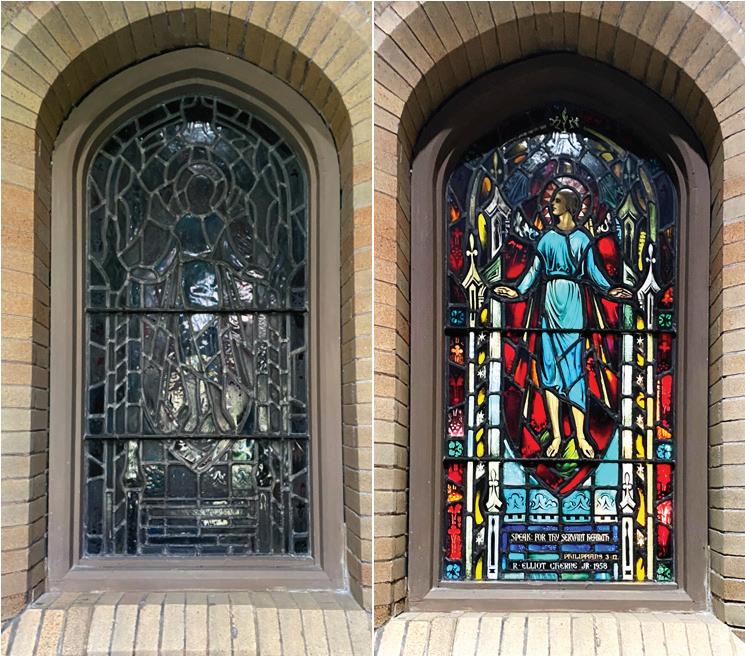
The four windows in the nave and the one in the north wall of St. Peter’s Chapel are devoted to saints who were prominent in the life of St Paul: St. Barnabas, St. Silas, St. Lydia, St. Timothy, and St. Luke. The two side lancets of each window show incidents in the lives of the saint, and below each panel in the quarry field are parallel incidents taken from the Old Testament or from the Gospels. In the top of the side lancet and the tracery of each window are six little figures holding scrolls and miniature cities representing 24 places connected with St. Paul’s ministry and grouped around the Saint with whom they are most closely associated. In the top of the side lancets and the tracery above are 12 cherubs, symbolizing the apostles. Scattered throughout the windows are crosses of various types and other early Christian symbols such as anchors and Greek letters which stand for Jesus or the Christ. The lives of these saints exemplify certain virtues, and these are suggested by symbolizing the opposite vice on a pedestal under their feet. All were created by Connick Brothers of Boston and installed between 1925 and 1957.

St. Silas, as Bishop of Antioch: The east nave window, second from the transept, features St. Silas. In the center panel the saint holds the fifth chapter of Peter’s first Epistle and a bishop’s crozier as Bishop of Antioch.
In the left panel, the jealous Jews in Thessalonica assault the House of Jason (Acts 17:5). Below, in a quarry field the men of Sodom are shown assaulting the angels of the Lord (Genesis 19:1).
In the right panel, St. Paul and St. Silas are delivered from prison in Philippi by an earthquake. “A great earthquake opened the prison doors” (Acts 16:25). Below, Daniel is being released from the lion’s den (Daniel 6:20-22).
St. Silas, in cooperating with St. Paul, exemplified Unselfishness. Therefore, under him is placed the figure of a man holding a moneybag to his breast as a symbol of Selfishness. Above are the cities of Athens, Corinth, Thessalonica, Beroea, Samaria, and Caesarea which St. Paul and St. Silas visited. History to 1977, p 43-44
The four windows in the nave and the one in the north wall of St. Peter’s Chapel are devoted to saints who were prominent in the life of St Paul: St. Barnabas, St. Silas, St. Lydia, St. Timothy, and St. Luke. The two side lancets of each window show incidents in the lives of the saint, and below each panel in the quarry field are parallel incidents taken from the Old Testament or from the Gospels. In the top of the side lancet and the tracery of each window are six little figures holding scrolls and miniature cities representing 24 places connected with St. Paul’s ministry and grouped around the Saint with whom they are most closely associated. In the top of the side lancets and the tracery above are 12 cherubs, symbolizing the apostles. Scattered throughout the windows are crosses of various types and other early Christian symbols such as anchors and Greek letters which stand for Jesus or the Christ. The lives of these saints exemplify certain virtues, and these are suggested by symbolizing the opposite vice on a pedestal under their feet. All were created by Connick Brothers of Boston and installed between 1925 and 1957.
St. Barnabas, a Levite: The east nave window, nearest the transept, is devoted to St. Barnabas. In the center panel stands the Saint who introduced Paul to the Apostles and convinced them of Paul’s true conversion, for they had known of him only as Saul the persecutor. St. Barnabas is holding the Gospel of St. Matthew, of which he was very fond, and the cross (one of his emblems). He was a member of the priestly Levite family, and is dressed accordingly.
The panel in the left lancet depicts St. Barnabas placing his money at the feet of the Apostles after selling his lands (Acts 4:3637). Below is the parallel incident of Christ bidding the wealthy young ruler to give up his riches and follow Him (Matthew 19:2123).
The panel in the right lancet represents St. Paul and St. Barnabas bringing relief to the Elders at Jerusalem during a famine (Acts 11:29-30). Below, in the quarry field, is a parallel incident from the Old Testament— Elisha feeding 100 men with 20 loaves (II Kings 4:42).
St. Barnabas is arguing for Paul to the apostles, showing the virtue of Discernment, so a blindfolded figure symbolizing the opposite vice of Stupidity is placed under his feet. Above are the six cities: Tarsus, whither St. Barnabas went to fetch St. Paul; Jerusalem, where St. Paul and St. Barnabas brought relief to the elders; Derbe and Antioch, where they were first called Christians (Acts 11:260; and, Perga and Iconium, whither St. Paul and St. Barnabas journeyed.
The window was given in memory of James Goold Cutler (1848 – 1927).
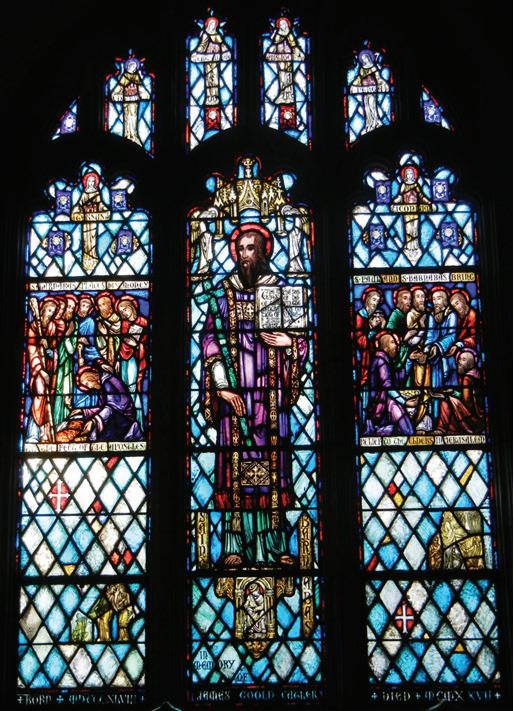
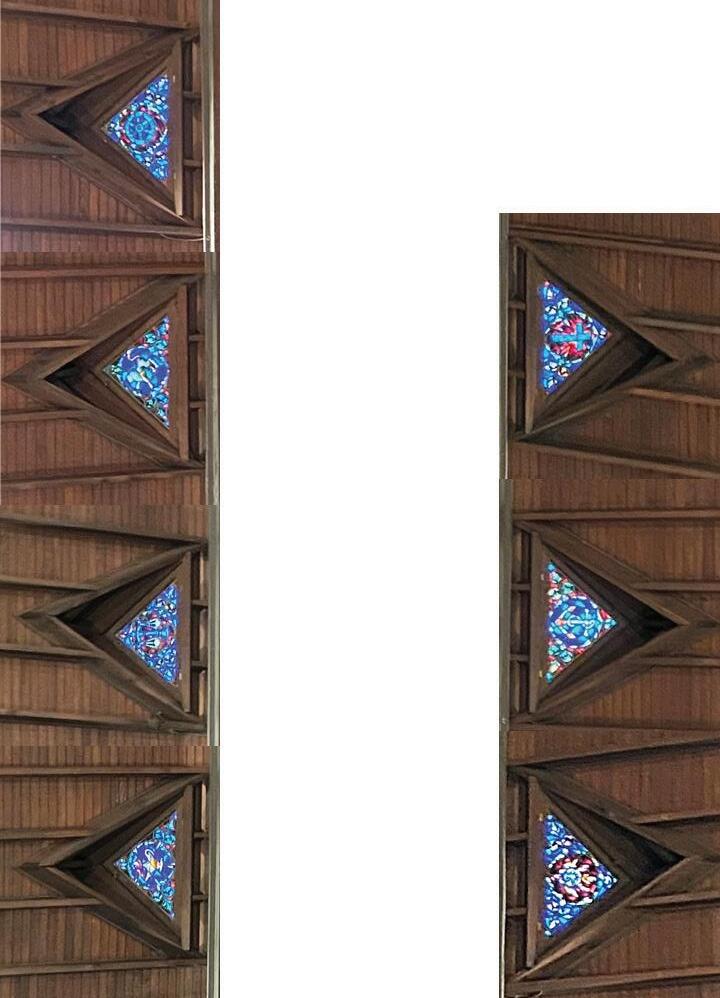
In the gables of the Nave roof are seven clerestory triangular windows representing the seven virtues.
On the east side are the four worldly virtues (from top to bottom at the left):
* the Wheel of Temperance,
* the Lion of Courage,
* the Scales of Justice, and
* the Lamp of Truth.
On the west side are the three theological virtues (from top to bottom at the right):
* the Cross of Faith,
* the Anchor of Hope, and
* the Rose of Charity.
They were created by Connick Brothers of Boston and installed in 1956.
The four windows in the nave and the one in the north wall of St. Peter’s Chapel are devoted to saints who were prominent in the life of St Paul: St. Barnabas, St. Silas, St. Lydia, St. Timothy, and St. Luke. The two side lancets of each window show incidents in the lives of the saint, and below each panel in the quarry field are parallel incidents taken from the Old Testament or from the Gospels. In the top of the side lancet and the tracery of each window are six little figures holding scrolls and miniature cities representing 24 places connected with St. Paul’s ministry and grouped around the Saint with whom they are most closely associated. In the top of the side lancets and the tracery above are 12 cherubs, symbolizing the apostles. Scattered throughout the windows are crosses of various types and other early Christian symbols such as anchors and Greek letters which stand for Jesus or the Christ. The lives of these saints exemplify certain virtues, and these are suggested by symbolizing the opposite vice on a pedestal under their feet. All were created by Connick Brothers of Boston and installed between 1925 and 1957.
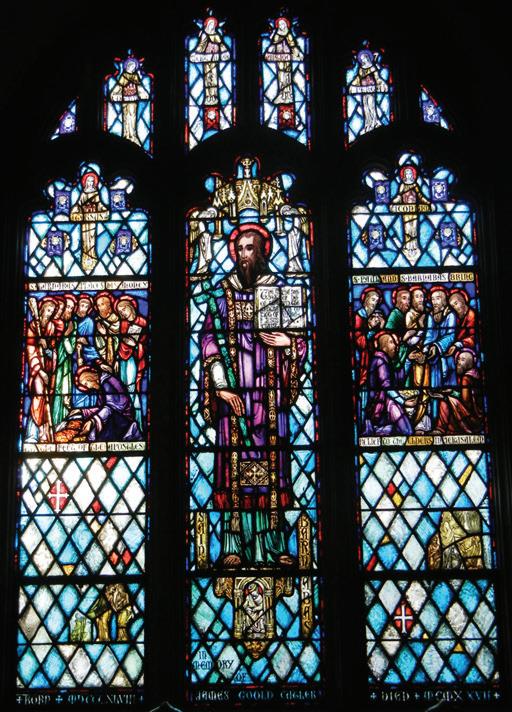
On the north wall of the east Transept, in St. Peter’s Chapel, the central figure is St. Luke the Evangelist—the companion of St. Paul and author of the Third Gospel and the Acts of the Apostles. He holds a tablet in his hand on which he has just written, “For unto you is born this day…a Savior which is Christ the Lord” (Luke 2:11). Six angels at the top of the window continue the Christmas message, “Glory to God in the highest and on earth peace to men.”
In the left panel, Paul, Silas, and Luke set sail from Troas to Philippi. At this point, the “we” passages from St. Luke’s travel diary first appear, and mark the spread of Christianity from Asia to Europe (Acts 16:6—10).
The right panel shows St. Paul in prison in Rome dictating letters to the Colossians and to Philemon. St. Luke and St. Aristarchus are with him. These letters speak of the breadth of the Christian Gospel. “There is neither Greek nor Jew, but Christ is all and in all” Colossians 3:110.
Below are vignettes that depict scenes characteristic of St. Luke’s writings: The Annunciation (Luke 1:26-38); St. Mary’s Magnificat (Luke 1:46-55); St. Paul healing Eutychus in Troas (Acts 20); and Simeon’s Nunc Dimittus (Luke 2:22-32). A painter’s pallet, doctor’s caduceus, and mortar and pestle in the quarry field signify St. Luke’s position as a painter and physician, and remind us that hi is considered the patron saint of both. On the pedestal below his feed is his evangelistic symbol—the Winged Ox—pertaining to his writing of the sacrificial ministry of Christ.
The window was given in memory of Adam and Eliza Gertrude Stallknight, Charles Henry Stallknight, and Raymond Gray Stallknight.
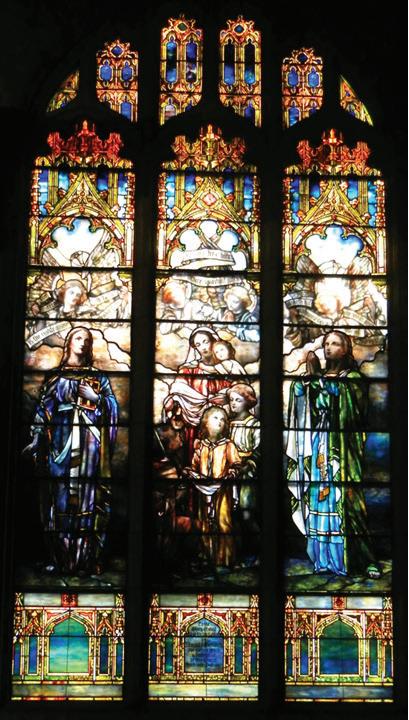
The Phoenix Rising From the Ashes (symbol of resurrection)—was created by Connick Brothers of Boston and installed in 1977 in memory of Frances MillsAnwyl (1891 – 1966) and James Gwilym Anwyl (1889 –1983).
Faith, Hope, and Charity:
In St. Peter’s Chapel is another Tiffany window from the same period as those in the Chantry with three women representing Faith, Charity, and Hope, and angels above holding the following Bible texts:
“For therein is the righteousness of God revealed from faith to faith” (Romans 1:17); “Follow after charity and desire spiritual gifts” (Cor.14:1); and “Hope maketh not ashamed because the love of God is shed abroad in our heart” (Romans 5:5).
Faith, robed in blue signifying Divine Wisdom, holds a Bible. Charity, robed in red signifying Divine Love, holds a money bag. Hope, robed in green (her color) has her symbol, an anchor, in the sash hanging from her waist.
This Tiffany window was dedicated in 1899 in memory of Edmund F. Woodbury, ‘for sixteen years a Vestryman of this Parish’ (1829 – 1892).

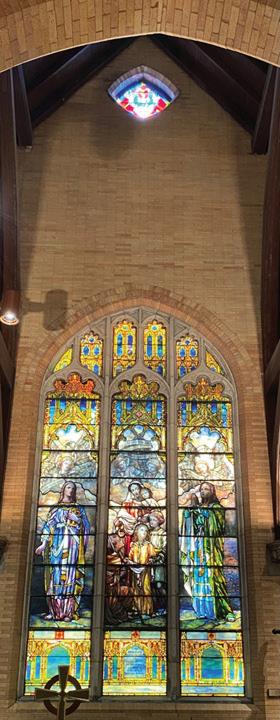
28, 29, 30, 31:
In 1934, the Chapel was given by members of the parish in memory of Lillian Drouet Norton, the wife of the Reverend George E. Norton, St. Paul’s rector from 1923 – 1948.
The Chapel has four small lancet windows showing Jesus Raising Lazarus (John 11:17-44); Jesus blessing children); Jesus turning water into wine at Cana in Galilee (John 2:1); and, near the altar, the figure of Jesus with his right hand raised in blessing (Mark 10:13-16) and holding in his left hand a chalice filled with wine.
All four windows were created by Connick Brothers of Boston and installed in 1957. The windows were given in memory of Ruth Wilson Farrow, 1898-1947.

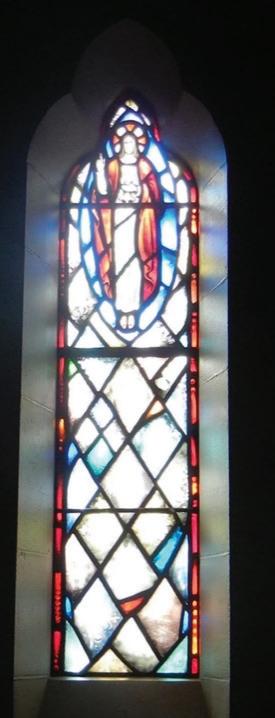
St. Mark and St. John:
The clerestory window in the Chancel side has two panels.
St. Mark, on the left, holds the evangelistic pen and book inscribed with his symbol of the winged lion, while St. John, on the right, holds a chalice.
Their evangelistic symbols, the winged lion and eagle, are represented with their names below. Flames of heavenly zeal appear in the lancet heads with the radiant winged Seraphim of divine love.
Both were created by Connick Brothers of Boston and installed in 1957 and were given by Linda Grove Slade.
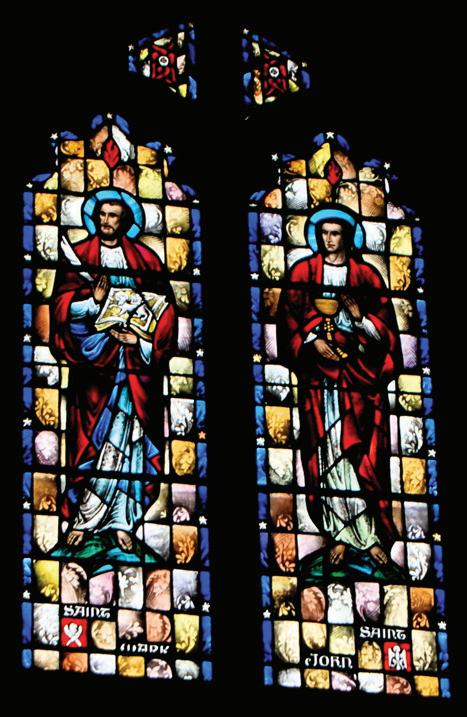

ABOVE: Close-up view of window
LEFT: More panoramic view showing placement of the window high in the Chancel
The windows at either side of the altar depict the four major Archangels. Those on the left represent St. Michael and St. Gabriel. Michael, Captain of the Hosts of Heaven, carries the flaming sword and shield as legend says he used when fighting Satan for the body of Moses. The shield is inscribed with the Scales of Justice, signifying the weighing of souls. Gabriel, Messenger of Peace and Glad Tidings, holds the lily, a symbol of purity and the annunciation of Mary. Lilies also appear on his garment and can be found near the name below, similar in position the cross accompanying St. Michael’s name. Flames of divine zeal in the lancet heads, and Seraphim of Heavenly Love in the tracery members, complete the symbolism.
To the right of the altar are St. Raphael, the Guardian Angel, with his travelers’ staff and symbol of the fish (recalling the story of Tobias from the book Apocryphal book, Tobit, and St. Uriel, Regent of the Sun, as named in “Paradise Lost” by Milton, with his radiant symbol.
All four windows were given by the parish to the glory of God. They were created by Connick Brothers of Boston and installed in 1957.
Angel Michael, Captain of the Hosts of Heaven, holding a flaming sword and shield with scales of justice.
Angel Gabriel, Messenger of Peace and Glad Tidings, holding Mary’s symbol, the Lily.
Angel Raphael, the Guardian Angel, with traveler’s staff and with Fish (Tobit 6:3).
Angel Uriel, Regent of the Sun, as mentioned in Milton’s Paradise Lost.


The marble Sanctuary Altar with Maltese Cross and Angels was brought to the new church building from the original St. Paul’s/Grace Church. In September 1880, the children of George Huntington Mumford and Ann Hart Mumford, while touring in Italy, purchased a richly carved alter just as it stood in the sculptor’s studio and had it shipped to St. Paul’s as a memorial to their parents. It was consecrated on the following All Saints Day. The altar was transferred to its present location in 1898, just after the new St. Paul’s Church opened. Originally it was attached to the reredos wall according to liturgical practice at that time.
In the 1970s, the National Episcopal Church voted to encourage parishes to move their altars from walls so clergy could face congregations during the Eucharist. St. Paul’s leaders discussed options for many years, since the beauty and integrity of the sanctuary were essential and the process involved would be time consuming and expensive. Upon Vestry approval in 1986, the DeSpirt Mosaic and Marble Company moved the altar from the wall to its current free-standing position. The process involved moving and resetting the altar front, placing a marble floor where the altar originally rested, installing marble on the exposed wall opening left by moving the altar, installing marble on the back of the newly placed altar, and moving forward the top two stair treads to increase the floor space behind the newly placed altar.

AThe original Altar Rail at this site was made of Verona marble. In 1936, the present rail with its bronze gates was given as a memorial to Joseph Warren Cutler, and the original rail went to Corpus Christi Church.

LEFT: Original altar rail topped by Verona marble.
RIGHT: Present rail with its bronze gates

The reredos was constructed in place around the altar in the new sanctuary and was not completed until 1904. It has been in place since April 17, the Second Sunday after Easter that year.
The reredos was created to fit the architecture of the church (English Gothic). The general design was created by George L. Heins and LaFarge, New York, the architects of the church. It includes four decorative media: mosaic, terra cotta, stone, and marble. The plan was to blend the mosaic full of color but devoid of form, and stone to be all form and no color, and the terra cotta for both color and form.
The marble wainscot and stone piers and framework were furnished by Barr, Thaw and Fraser of Hoboken, who were also contractors for The Cathedral of St. John the Divine in New York City. The marbles are green serpentine, Verona, Siena, and white statuary. The stone is Frontenac, a dolomite from Minnesota. The mosaics were made in Venice, Italy, and the terra cotta was executed by the Rockwood Pottery of Cincinnati.

The two angel sculptures at the top of the piers are Contemplation and Prayer by Max Schwartshod of New York. The canopies over the statues incorporate the symbols of the four Evangelists, the angel of St. Matthew, the lion of St. Mark, the ox of St. Luke, and the eagle of St. John. On the bases of the canopies are the sacred monograms, Alpha Omega, and Chi Rho, also the symbols of the Passion.
Within the stone framework which weighs over ten tons (supported by brick walls in the basement), a broad border of colored terra cotta represents the symbols of the Eucharist. The colors of the grape clusters with vines and leaves, were not brushed on but were produced by chemical action in a kiln.
Christ is depicted with hand uplifted in blessing as the central figure; his halo is made of mother of pearl. To his left stands St. Paul with his symbol, the sword of the spirit. St. Peter with his symbol, the golden keys, appears to the right of Christ. These panels, all original in design, are in the style of the mosaics in the medieval churches of Ravenna and Venice. They are made of minute pieces of enamel by the same process used by Byzantine artists centuries ago. The mosaic was manufactured in the great Venetian works of Murano and the Grand Canal, and was set in place by Julius Talamini, their representative in this country.
C Processional Cross (designed by Ralph Adams Cram)—Louis C. Tiffany Studios of NYC; 1922:

For centuries, crucifixes or crosses have been carried in Christian processions. Our processional cross was created in 1922 by George E. Germer of Tiffany’s, one of the country’s finest jewelers who was well known for designing and creating beautiful hand-wrought ecclesiastical pieces. He created the cross in silver after a design by Ralph Adams Cram. Each tiny piece was molded separately, then joined, and bathed in pure gold.
The cross is gothic in design in keeping with the Church building. Since it is budded or enlarged at the ends, it represents the Cross Triumphant. An amethyst heart in the center symbolizes the Christ; the fleur-de-lis or lily symbolizes immortality; and the small prongs at the ends of the shafts and the old Chinese crystals symbolize light. Thus, the Cross symbolizes light, victory, and immortality through Jesus Christ.
The cross was given in memory of Elizabeth Conkey Sibley, wife of Rufus Adams Sibley, by her children, Elizabeth Sibley Robins and John Russell Sibley.
In 2016, an extensive restoration of the cross was required due to the wear and tear it had endured over the years. Canal Metalsmiths straightened it, re-gilded it, and set in new stones to replace those that had fallen out. The restoration was done in thanksgiving for the life of Susan Hasson Green.

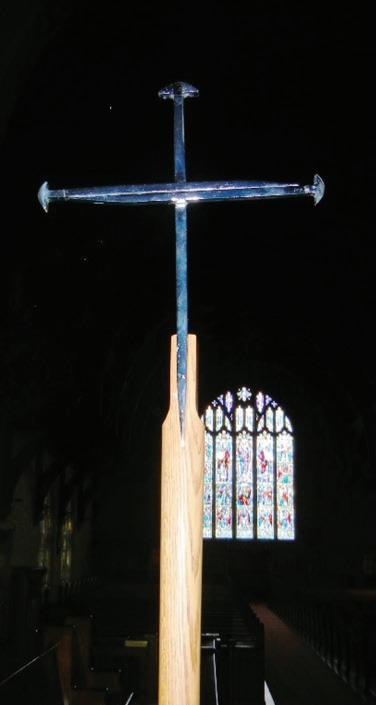
DBELOW:
A Coventry Cross of Nails is made from iron nails used to symbolize peace and reconciliation. The original version was made from three large medieval nails salvaged from the Coventry Cathedral after the building was severely damaged by German bombs on 14 November 1940 during World War II. The original cross of nails resides in the cathedral that was rebuilt after the war.
Over the years, hundreds of nail crosses have been given to various organizations, originally using medieval nails from the old cathedral but more recently using modern replicas. The recipients of nail crosses from Coventry were brought together in 1974 to form an ecumenical “Community of the Cross of Nails”, developed by the Very Rev. H.C.N. Williams, 19581981 Coventry Cathedral Provost. The network of over 200 organizations in 45 countries—including the United Kingdom, Germany, United States, Scandinavia, Australia, and Borneo— shares a commitment to peace, justice, and reconciliation.
Provost Williams visited St. Paul’s on September 15 – 17, 1965. He was Provost during the building of the new Coventry Cathedral which had been erected at right angles to the remains of the original bombed-out cathedral. On September 15, he presented a Cross of Nails to St. Paul’s and stated that our parish is remembered on the 28th day of each month in the prayers at all services at Coventry Cathedral as part of their support for our ministry of reconciliation.
The Coventry Cross of Nails Processional Cross is used in Lent and in processions where more than one Processional Cross is needed. The Cross consists of three nails, one of which is from the ruins of the 14th century cathedral while the other two are replicas.
The Cross of Nails was mounted on a sailboat spar by David Tappan, a former Vestryman and Property Committee Chairperson, in 1970 to be used in processions.


In 1927 a subscription produced the Centennial Memorial Organ, a superb instrument, then the largest in any Rochester church, and considered one of the finest in the country. It was dedicated on Christmas Day; the first Hymn played on the new organ was “O, Come, All Ye Faithful.” The first concert was given in January by new parish organist Warren Gehrken.
The organ was built by the E. M. Skinner Organ Company, the foremost American organ builder from 1905 until it merged with the Aeolian Organ Company in 1932. Experts believe that the “golden years” for Skinner occurred in the late 1920s. St. Paul’s is fortunate to have one of that vintage. Of about 700 Skinner organs created, only about 100 remain, including ours.
In 2009 our congregation chose to restore the organ to its original splendor. The restoration was led by our Director of Music, Dr. Robert Poovey, and our consultant, Jonathan Ambrosino, an authority on Skinner organs. The major work was accomplished by the Parsons Pipe Organ Builders of Canandaigua. A. Thompson–Allen Co. restored the console and harp/celesta unit, and Broome & Co. restored the reed pipes. The project took eighteen months and cost $1.2 million, which was raised by donations from parishioners, friends of former parish organist Dr. David Craighead, and a grant from the Joseph G. Bradley Foundation.
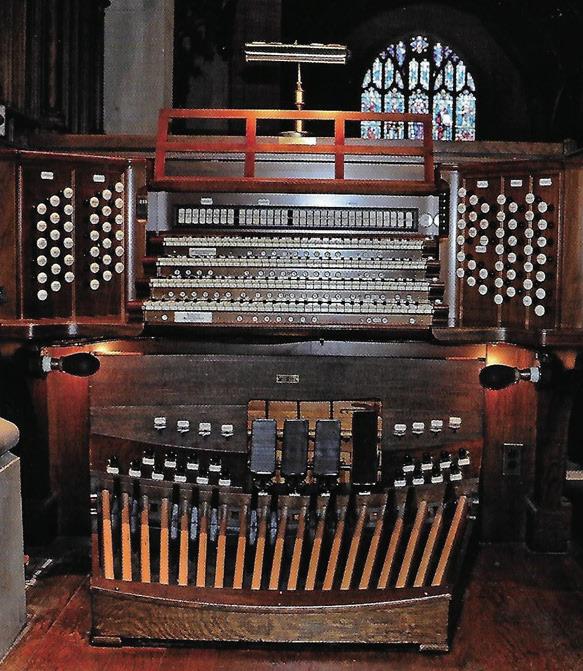
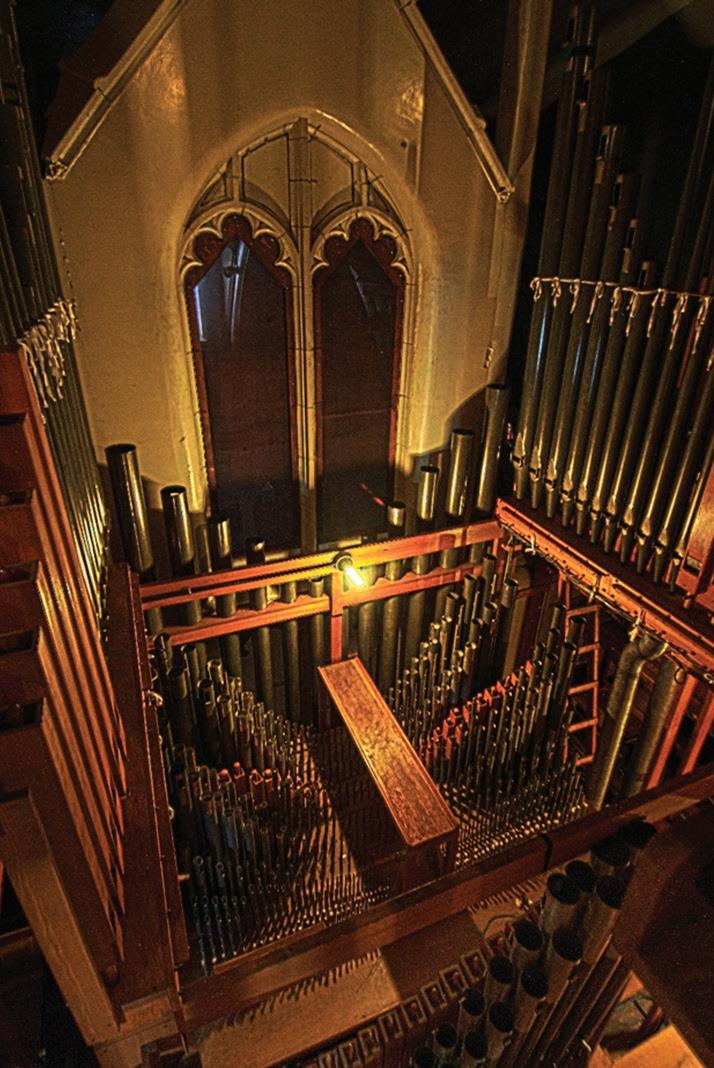
BELOW: A portion of the 4,474 pipes that were restored and revoiced back to E. M.
specifications.
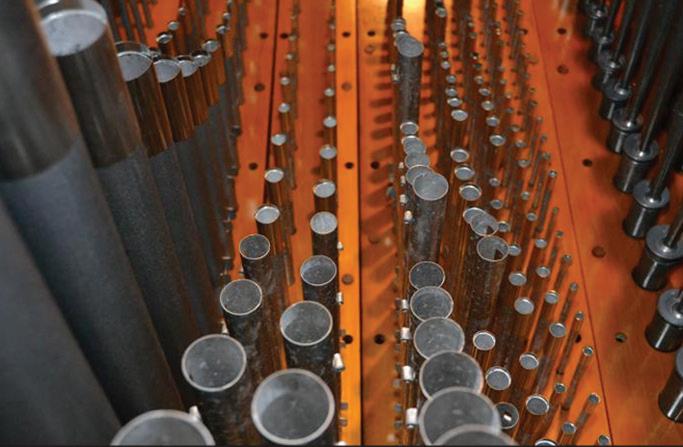
St. Paul’s contains myriad wood sculptures by noted craftsman Thillman P. J. Fabry and his employees. Notable are the lectern with a carved eagle, the symbol of St. John, and the pulpit with its carving of St. Paul holding the sword of the spirit (see pictures at right).


FPictured in the left column and bottom right are other examples of Fabry woodworking found in St. Paul’s.

G(See also Item N.)
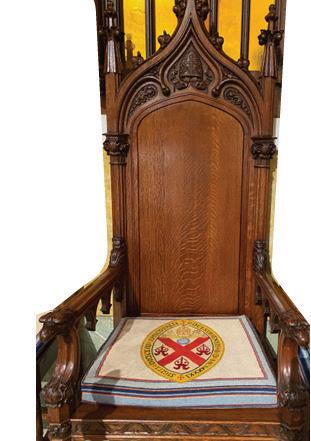
H
Marble Baptismall Font:
Some of the furnishings from Grace/St. Paul’s Church were taken to the new location and are still housed in our Sanctuary. Among these items is the Italian marble Baptismal Font which sits in the Chantry.
The Reverend and Mrs. Louis C. Washburn gave the marble font as a thank offering at the time of the baptism of their daughter, Henrietta Mumford Washburn. The Rev. Mr. Washburn was the rector of St. Paul’s from 1888-1895.

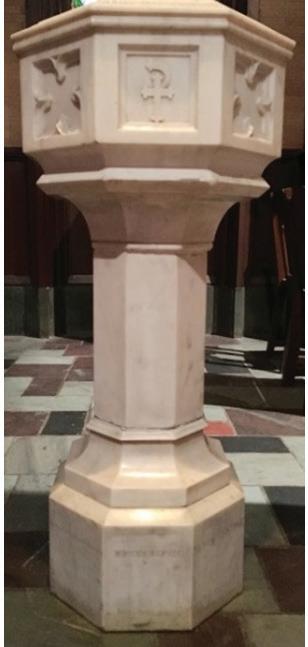
ILEFT: Drawing of former St. Paul’s/Grace Church showing our current high altar; the marble baptismal font; and stained glass windows which today are found on either side of the altar in the chantry and in the west ambulatory.
Wooden Baptismal Font:
The St. Paul’s Vestry voted in October 1991 to dedicate the new moveable wooden Baptismal Font in memory of Joan “Wanny” Moore (1934-1991), a former vice principal of Rochester CSD School #9, a Vestry member, and an Altar Guild member.
Because it is easier to move, it is used in all baptisms that occur in the Chancel or center of the Nave.

On November 1, 2008, the Agnes Dei (Lamb of God) banner, which was handcrafted by parishioners, was dedicated. It was a thank offering designed by Altar Guild Member Francis Speer, championed by Altar Guild Director Mary Critikos, and stitched by Gail Bush, Gwen Cheney, Joan Flint, Jean French, Susan Hyde, the Rev. Tom McCart, Carol Panzer, Donna Suchy, Barbara Warner, and Nancy Wolcott. The banner’s support pole was designed and built by Joe Willard.

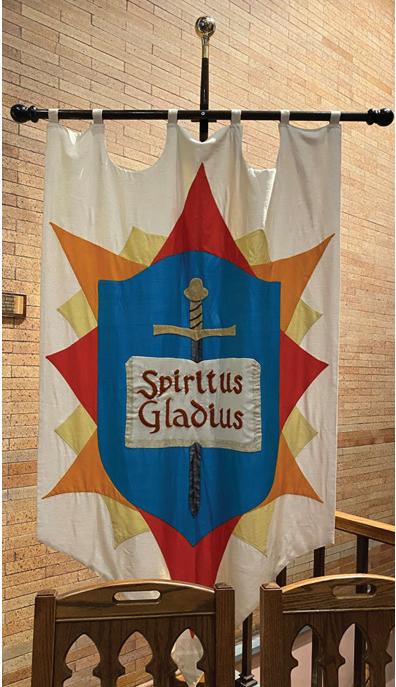
A group of parishioners created this banner over a two-year period to commemorate St. Paul’s 150th anniversary. It was dedicated to the Glory of God on the occasion of the parish’s sesquicentennial (1827-1977) on May 12, 1977. The banner was intended to be carried in a procession and to stand in place. Peggy Fitter produced the design while Libby Skerritt and Eleanor Warren did much of the stitching. Others involved were Nan Brown, Peggy Fitter, Do Foland, Sue Neumer, Adelaide Smith, and Ann Vilas.

The silver cross hanging behind the altar in the Norton Chapel was designed and crafted by Hans Christensen, renowned silversmith and professor of contemporary crafts at RIT’s School of American Crafts from 1954-1983.
Seen are the cross in place behind the Norton Chapel altar as well as a close-up of the cross on the wall.
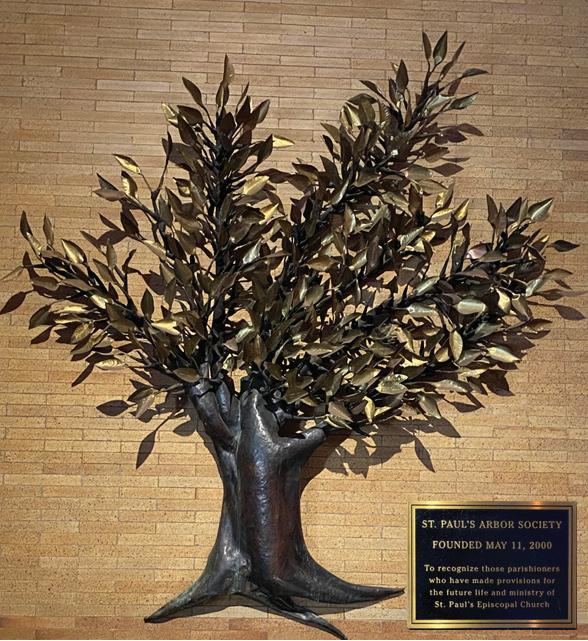
M Arbor Society Tree: The Arbor Society was established in 2000 to recognize those parishioners who have made provision in their wills to include a gift to St. Paul’s Church. Such gifts ensure that St. Paul’s will flourish, to serve our children and our grandchildren for years to come.
The copper Arbor Tree wall art with bronze and brass leaves was created by artist David Stephanus of the Rochester Institute of Technology School for American Craftsmen. It was dedicated on March 5, 2000, fulfilling a decade long initiative of the Vestry and Jeanne Hutchins, Chair of the Vestry’s committee on planned giving.

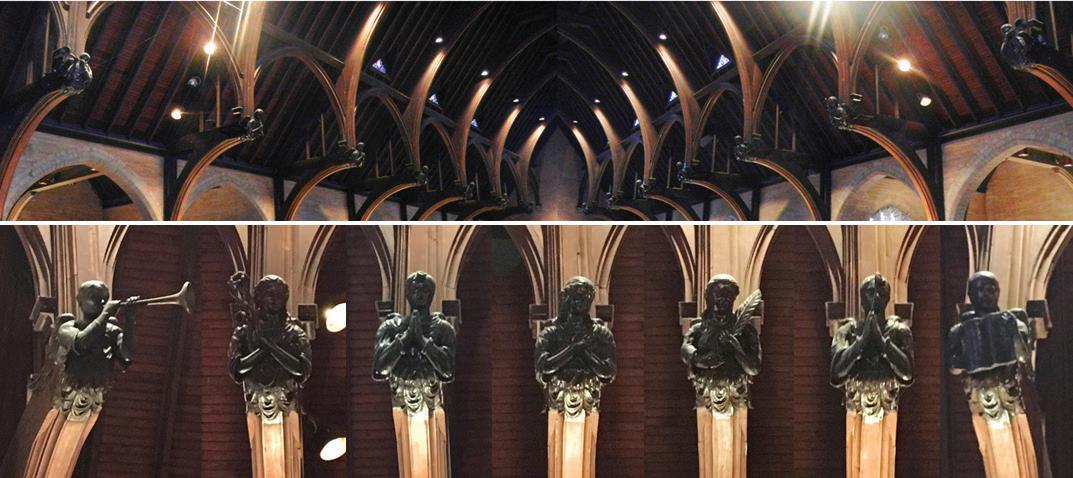
ABOVE: Hammer beams in the top row with enlargements of their seven carved angels in the next row Showing them blowing horns, waving palm leaves, and pressing hands in prayer, among other activities.
RIGHT: Decorative woodwork in arches behind choir stalls.
NThe artisan responsible for much of the carved wood in St. Paul’s Church, Thillman P. J. Fabry, was born in Prussia in November 1857. He was brought by a relative in 1871 to Providence, Rhode Island, where he was apprenticed in wood carving for a furniture manufacturer. After completing his apprenticeship at age 18, and serving in the army until 1881, he moved to Rochester. Here he practiced his craft for many years from a studio at 48 North Water Street. He created many works of art that adorn buildings in Rochester and earned a national reputation for his excellent carvings and plaster moldings. Hiram W Sibley, son of Hiram Sibley of Western Union Telegraph Company fame, commissioned Fabry to provide these architectural details in St. Paul’s Church. (See also Item F.)
Much later, a carved screen was added to separate the Nave from the Narthex. This screen as well as benches and tables along the rear wall were given as a memorial to Raymond Albright in 1962.
BELOW: Decorative screen separating Nave seating from the Narthex.
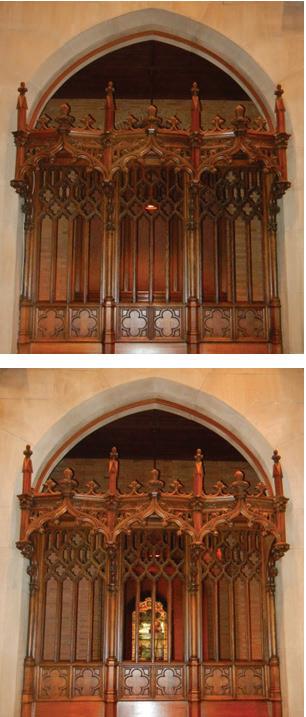


The St. Paul’s kneelers project, which lasted close to 10 years during the 1980s, was featured in the news . (Fran Cruikshank. “Lovely to Look At…Lovely to Kneel On.” Brighton Pittsford Post. December 22, 1982). The picture above accompanied the article.
Some of St. Paul’s exceptional works of art were lovingly handcrafted by dedicated parishioners. Primary among these items are the 556 needlepoint kneelers found in the pews of the nave, chantry, and Norton Chapel. The needlepoint project is notable for its scope: the quantity of kneelers produced, the numbers of parishioners involved, and the usefulness of the works of art to worshippers.
Sisters Vail Whitbeck and Molly Poole organized this parish-wide effort which involved 200 parishioners in creating the kneelers. The kneelers picture biblical stories and scenes, hymns, crosses, and other Christian symbols in designs selected for their religious significance. The project took 10 years to complete. As kneelers were completed, they were accepted during a worship service.
All the kneelers were catalogued by artisan and pattern in a directory produced by Gwen Cheney. This information as well as photographs of the kneelers were organized by archives committee members Ruth Hazzard and Diane Healy in 2023. To learn more, contact the church office to be connected with the Archives Committee.
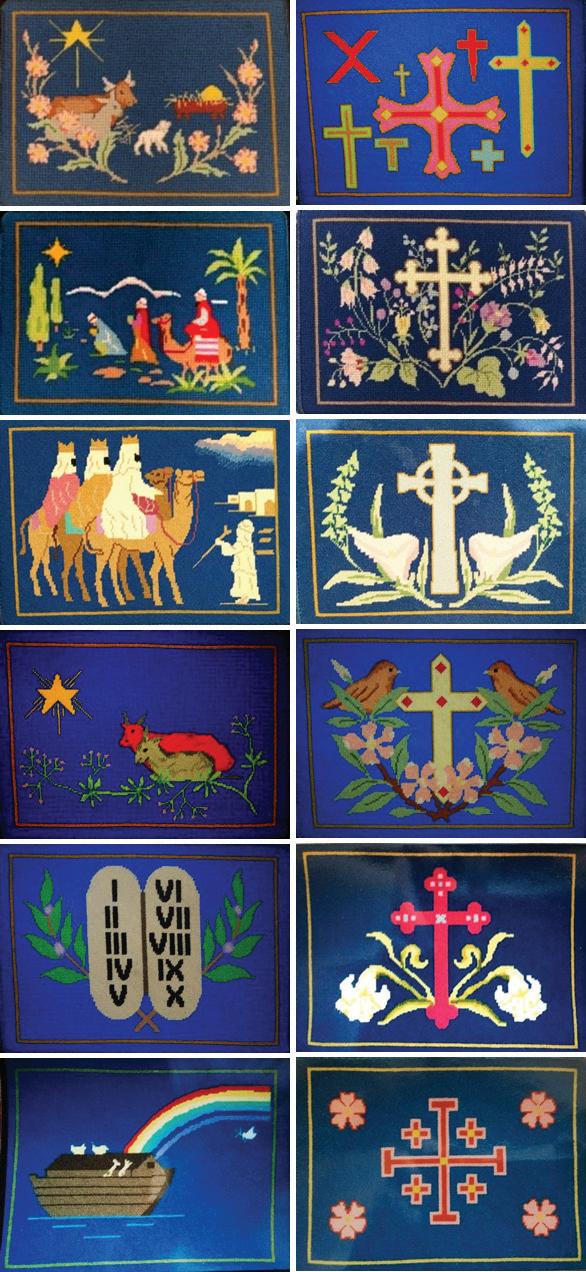

Among the furnishings from Grace/St. Paul’s Church that were brought to the new location on East Avenue was the bell housed in the belfry that is rung just before every 10:15 am service on Sundays. The bell dates from about 1835.
LEFT: Bell seen through tower window.
BELOW: Bell seen from top of bell tower.


1 1 1 1 6 3 5 3 6 6
Orin E. Skinner of Charles J. Connick Associates Boston, whose firm created many of St. Paul’s windows, has written that from the Middle Ages -
1. LANCET: Narrow vertical division of a window having a pointed Gothic arch at the top, used singly or in multiples forming a larger Gothic window.
2. PANEL: Unit of stained glass leaded together and made to fit an opening in the framework of a window. May be of any shape. A single window is, as a rule, made up of several panels.
3. QUARRY: (from French carré, square): a small pane of glass, usually diamond-shaped. Diamonds or rectangles of glass leaded together in a lattice design. They are often used in multiples to make up whole windows, or as a decorative background.

4. RONDEL ( ROUNDEL): A general term used to denote a unipartite panel, usually circular, but sometimes oval or even rectangular, bearing a selfcontained design.

5. ROSE WINDOW: A large circular window opening, usually divided by stone mullions, and surrounded by tracery, most often composed of stained- glass panels radiating from the center; a circular window divided by radial mullions, usually in a floral or wheel pattern.
6. TRACERY: Openwork pattern of stone or wood in the upper part of an opening in a window or screen; small, often ornate and ornamental, openings at the top of a window. 4

* Red represents diving love, passionate devotion, self-sacrifice, courage, and martyrdom. The Seraphim, nearest to the throne of God and symbols of diving love and adoration, have red wings.
* Blue is the graciously supporting color of red, and is seen as contemplative, and representative of divine wisdom, eternity, heaven, and loyalty. Cherubim have blue wings.
* Green is the color of hope, springtime, youth, and victory.
* Gold symbolizes spiritual treasures, worthy achievement, and the good life.
* Violet symbolizes justice, mystery, pain, and penitence.
When the old St. Paul’s on St. Paul Street was sold in 1896, the vestry retained the right to take the altar, the bell, the tower clock, the marble baptismal font, the wooden chapel in the rear, and several memorial stained-glass windows to the current building.
The largest group of St. Paul’s stained-glass windows were made by the Connick firm between 1924 through the mid 1950s as a project financed by James G. Cutler, who donated the first of these windows for the Narthex (The Great North Window) in 1924, in memory of his wife, Anna Katherine Abbey Cutler. Mr. Cutler commissioned Mr. Connick to draw sketches for future windows in the nave to encourage artistic and religious continuity. To ensure the success of this plan he persuaded the Vestry in 1927 to move the Bissell window (St. Paul in Athens) from the Nave to the north wall of the Chantry, and donated funds for the St. Barnabas window to be put in its place. Not until the 1950s were the rest of the Nave windows in his plan completed. Enough momentum was generated at that time to also create stained glass windows for the Chancel, Sanctuary, Nave gables, entranceways, St. Peter’s Chapel, and the Norton Chapel.
Lightning struck the southwest turret of the church on Sunday, August 21, 1927, knocking off part of the stone work and a gargoyle. Two heavy stones crashed through the roof, damaging pews and the nave floor. Fortunately, no service was in progress at the time. Lightning rods were installed and the problem has not recurred.
St. Paul’s Parish is fortunate to have its sacred space adorned with so many works of art designed to encourage worship.
O God, whom saints and angels delight to worship in heaven: Be ever present with your servants who seek through art and music to perfect the praises offered by your people on earth; and grant to them even now glimpses of your beauty,and make them worthy at length to behold it unveiled for evermore; through Jesus Christ our Lord. Amen.
Book of Common Prayer, P. 819
Sources:
Original “St. Paul’s Church: A Self-Guided Tour” brochure by Gwen Cheney
St. Paul’s Episcopal Church 1827-1977 (a history)
Articles that originally appeared in “The Epistle”, St. Paul’s newsletter
Acknowledgements:
Gwen Cheney, who prepared the original “St. Paul’s Church: A Self-Guided Tour”
Sonja Slother, who prepared the campus map, finalized the layout/cover, and made this document electronically interactive. Joel Krenis, The Rev. Rob Picken, Bob Potter, Jean VerHoeven, and many other photographers. David White and Linda White who proofread and suggested additional helps for users.
Archives Committee members Linda White, Cheryl Bero, Ruth Hazzard, Diane Healy, and Peggy Willard who helped with research, and Judy Wadsworth, who prepared this self-guided tour.
June 2025